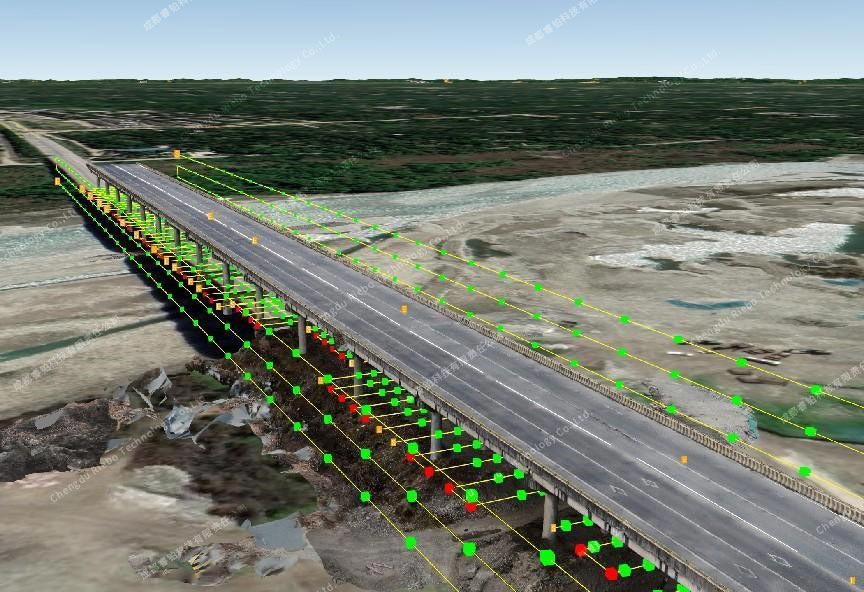Addressing the worldwide need for efficient bridge inspections, Riebo's bridge inspection solution combines cutting-edge imaging, AI-driven analysis, and digital twin technology to enhance infrastructure monitoring and maintenance. This advanced approach offers a streamlined, high-tech process designed to ensure efficiency, accuracy, and actionable insights for maintenance and management. Here's an overview of the key steps:
1.Digital Twin Creation
A realistic 3D model of the bridge is generated to provide a comprehensive understanding of its structure. This model serves as the foundation for planning and analysis.
 3D realistic modeling of bridges (overall)
3D realistic modeling of bridges (overall)
 3D realistic model of the bridge (partial)
3D realistic model of the bridge (partial)
The 3D reality model serves two main purposes:
- Defect Visualization: It acts as a digital map for visualizing and managing defects, enabling maintenance teams to intuitively assess the actual condition of the bridge.
- Route Planning: It provides the basis for autonomous drone flight path planning.
Riebo's M-series products and proprietary Riebo Route Assistant (RRA) software optimize modeling for bridges. This approach significantly reduces the number of flight paths and images, enhancing modeling efficiency. Testing shows that creating a 3D model for a 500-meter bridge takes only 111 minutes, including data collection.
2.Route Planning
Based on the digital twin, an optimized inspection route is designed, ensuring all critical areas are covered efficiently and safely.
 Automatic generation of inspection routes
Automatic generation of inspection routes
Drone inspection differs from standard aerial survey operations. According to stringent inspection standards, cracks as small as 0.1mm in concrete must be detected. This requires drones to fly close to the structure, ensuring safety in complex environments and complete image coverage through route planning.
The Riebo Route Assistant (RRA) software's inspection module generates simulation-based flight paths using 3D models. This process takes just five minutes per bridge. Combined with rapid modeling, it enables full inspections and modeling of standard scenarios within a single day.
3.Data Collection
Drones equipped with advanced cameras follow the planned route, capturing high-resolution images and positional data for thorough analysis.

The image data for inspections is collected using a drone equipped with a camera, requiring only one operator, one vehicle, and a set of equipment. Optimized route planning, combined with a professional-grade inspection camera featuring a long focal length and medium-format sensor, ensures high efficiency. Tests show that inspecting a 500-meter multi-span bridge takes only about 90 minutes in the field.
4.Data Processing
Collected data undergoes precise positioning and alignment to ensure spatial accuracy. The processed information is prepared for defect analysis.

Riebo's Skyscanner software, paired with its full range of cameras, facilitates efficient management of large inspection datasets by allowing batch export of collected data. The software embeds geographic information into photos for precise coordinate correction and calculates image field-of-view parameters based on the drone's and camera's orientation. This supports accurate defect localization for subsequent analysis.
5.AI-Powered Defect Recognition
Advanced algorithms identify and classify structural defects, providing detailed and reliable diagnostic results to support decision-making.
Advancements in convolutional neural network-based deep learning algorithms have made defect recognition using high-resolution inspection images more accessible and reliable.
- Training the Model: Images are labeled and used to train a neural network, enabling quick crack detection. The model’s accuracy improves with additional data and refinement.
- Image Processing: Identified defects undergo enhancement, denoising, segmentation, and edge detection, producing pixel-level measurements. Advanced algorithms ensure accurate results despite interference from small cracks, complex backgrounds, or markings.
Other defects, such as welding cracks, corrosion, and bolt loosening, are also detected.
6.Inspection Management
All collected data is integrated into a centralized platform for seamless oversight, real-time monitoring, and actionable reporting, streamlining the entire inspection workflow.
This integrated approach leverages cutting-edge technology to enhance safety, reduce costs, and deliver reliable insights for bridge maintenance.
Currently, most inspection operations result in reports that lack intuitive presentation, whether for specific defects or overall bridge condition. The inspection process also suffers from insufficient digital management, low reusability of results, and difficulty in supervision. Existing software often has low integration and limited data compatibility.
To address these challenges, Riebo developed the Tongtu Intelligent Inspection Management System, which digitizes and centralizes the entire inspection process. It integrates functions such as personnel and data management, defect recognition, 3D visualization, historical comparisons, statistical analysis, and customizable report generation.

